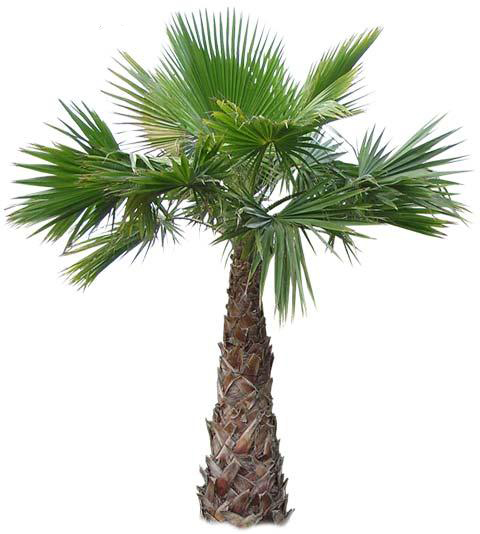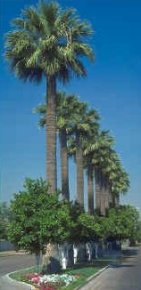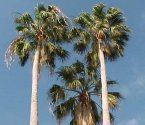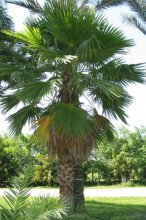Mexican Fan Palm Trees - (Washingtonia robusta)
Mexican Fan Palms (Washingtonia robusta) have many fine attributes including salt
resistance and fast rate of growth. The cold hardy Mexican Fan
Palm has a slender trunk
topped with crowns of large fan-shaped evergreen fronds.
Cold Hardy Mexican Fan Palm Tree Overview
Soaring to over 100 ft (30.5 m), this skyscraper of the
palm world is a striking sight. Mexican Fan Palms have:
- A gray trunk ringed with closely set leaf scars
although usually at least part of the trunks remain
covered with dead leaves that hang in a thatch.
- The solitary trunks, about 10-12 in (25.4-30.5 cm) in
diameter, bulge at the ground and become slender as they
approach a crown of large palmate leaves with
gracefully drooping leaflet tips.

Cold Hardy Mexican Fan Palm Trees
Overview
Large, rapid growing, and hardy all
describe the Mexican Fan Palms. Native to the riparian washes and
gullies of Northern Mexico, Baja, Southern California and
Arizona Mexican Fan Palm trees are very drought and salt
tolerant once established. Adapted to a wide range of soil
types, and climates. This species easily hybridizes with
the California/Desert Fan Palm (Washingtonia filifera)
and a wide variation in phenotypes (outward appearance and
growth characteristics) occurs under cultivated conditions.
Commonly seen at 40 to 50 feet but capable of soaring to 80 feet in height, Washington Palm is quickly recognized as the much-used, straight, single-trunked street palm of years past. The lower leaves persist on the tree after they die, forming a dense, brown, shaggy covering below the living, bright green, broad, fan-shaped leaves, giving it the common name of petticoat palm. These dead fronds are known to be a fire hazard and a popular bedding roost for rodents and, because of this, must be removed by law in some areas. The sharply barbed leaf petioles and tall, thin trunks make frond removal a rather unpleasant task, but some people think the rapid growth rate and statuesque appearance more than make up for this trouble.
Mexican Fan Palms Information
General Information
Scientific name: Washingtonia robusta
Pronunciation: wosh-ing-TOE-nee-uh roe-BUS-tuh
Common name(s): Washington Palm, Mexican Washington Palm
Family: Arecaceae
USDA hardiness zones: 8 through 11 (Fig. 2)
Origin: not native to North America
Mexican Fan Palm Tree Description
Height: 60 to 90 feet
Spread: 10 to 15 feet
Crown uniformity: symmetrical
Crown shape: palm, upright/erect
Crown density: open
Growth rate: moderate
Texture: coarse
Mexican Fan Palm Foliage
Leaf arrangement: alternate (Fig. 3)
Leaf type: costapalmate
Leaf margin: entire
Leaf shape: star-shaped
Leaf venation: palmate
Leaf type and persistence: broadleaf evergreen, evergreen
Leaf blade length: more than 36 inches
Leaf color: green
Fall color: no color change
Fall characteristic: not showy
Mexican Fan Palm Flower
Flower color: white/cream/gray
Flower characteristics: showy
Palm Fruit
Fruit shape: oval, round
Fruit length: less than .5 inch
Fruit covering: fleshy
Fruit color: black
Fruit characteristics: does not attract wildlife; not showy; fruit/leaves not a litter problem
Mexican Fan Palms Trunk and Branches
Trunk/bark/branches: branches don't droop; not showy; typically one trunk; thorns
Pruning requirement: little required
Breakage: resistant
Current year twig color: not applicable
Current year twig thickness:
Wood specific gravity: unknown
Mexican Fan Palm Tree Culture
Light requirement: full sun, partial sun or partial shade
Soil tolerances: clay; sand; loam; alkaline; acidic; occasionally wet; well-drained
Drought tolerance: high
Aerosol salt tolerance: high
Other
Roots: not a problem
Winter interest: no
Outstanding tree: no
Ozone sensitivity: unknown
Verticillium wilt susceptibility: resistant
Pest resistance: resistant to pests/diseases
Mexican Fan Palms Usage and Maintenance
Washington Palm makes a dramatic statement in the large landscape and creates a striking accent for multi-storied homes but often grows out of scale in most landscapes with one-story buildings because all of the fronds are at the top of the palm. It looks like a telephone pole with a green hat. Washingtonia filifera is a much better choice in unirrigated landscapes, since it grows more slowly, is shorter, and the trunk is thicker.
Washington Palm needs full sun for best growth but will endure some shade while young. It will tolerate poor soil and drought, and is hardy to about 20-degrees F. Transplant with a large root ball to ensure survival.
Washingtonia filifera is shorter, has a thicker trunk, and is better suited for planting in dry urban landscapes, such as in Texas. They reportedly suffer and often die from root rot when irrigated. Select Washingtonia robusta in an irrigated landscape and for the eastern U.S.
Propagation is by seed.
Mexican Palm Pests
Coconut mealybug, palm leaf skeletonizer, palm platid planthopper and a variety of scales infest this palm.
Mexican Fan Palm Diseases
Root rot can occur if this palm is planted on a wet site. |


Mexican Fan Palm
Small - $ 69.95
Retail Price: 83.94
You Save: $13.99

Mexican Fan Palm - Medium - $ 239.95
Retail Price: 287.94
You Save: $47.99

Mexican Fan Palm
Large - $ 309.95
Retail Price: 371.94
You Save: $61.99
Other Cold Hardy Palms you might be interested in:
True Date Palms (Phoenix dactylifera)
(Sabal mexicana)
(Butia capitata)
(Cycas revoluta)





|











